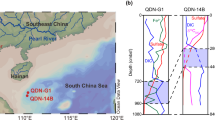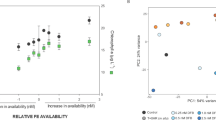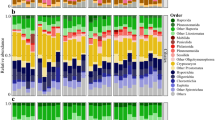Abstract
Despite over 125 years of study, the factors that dictate species dominance in neutrophilic iron-oxidizing bacterial (FeOB) communities remain unknown. In a freshwater wetland, we documented a clear ecological succession coupled with niche separation between the helical stalk-forming Gallionellales (for example, Gallionella ferruginea) and tubular sheath-forming Leptothrix ochracea. Changes in the iron-seep community were documented using microscopy and cultivation-independent methods. Quantification of Fe-oxyhydroxide morphotypes by light microscopy was coupled with species-specific fluorescent in situ hybridization (FISH) probes using a protocol that minimized background fluorescence caused by the Fe-oxyhydroxides. Together with scanning electron microscopy, these techniques all indicated that Gallionellales dominated during early spring, with L. ochracea becoming more abundant for the remainder of the year. Analysis of tagged pyrosequencing reads of the small subunit ribosomal RNA gene (SSU rRNA) collected during seasonal progression supported a clear Gallionellales to L. ochracea transition, and community structure grouped according to observed dominant FeOB forms. Axis of redundancy analysis of physicochemical parameters collected from iron mats during the season, plotted with FeOB abundance, corroborated several field and microscopy-based observations and uncovered several unanticipated relationships. On the basis of these relationships, we conclude that the ecological niche of the stalk-forming Gallionellales is in waters with low organic carbon and steep redoxclines, and the sheath-forming L. ochracea is abundant in waters that contain high concentrations of complex organic carbon, high Fe and Mn content and gentle redoxclines. Finally, these findings identify a largely unexplored relationship between FeOB and organic carbon.
Similar content being viewed by others
Log in or create a free account to read this content
Gain free access to this article, as well as selected content from this journal and more on nature.com
or
Accession codes
References
Bruun A-M, Finster K, Gunnlaugsson H, Nørnberg P, Friedrich MW . (2010). A comprehensive investigation of iron cycling in a freshwater seep including microscopy, cultivation and molecular community analysis. Geomicrobiol J 27: 15–34.
Chan CS, Fakra SC, Emerson D, Fleming EJ, Edwards KJ . (2011). Lithotrophic iron-oxidizing bacteria produce organic stalks to control mineral growth: implications for biosignature formation. ISME J 5: 717–727.
Chow AT, Dai J, Conner WH, Hitchcock DR, Wang J-J . (2013). Dissolved organic matter and nutrient dynamics of a coastal freshwater forested wetland in Winyah Bay, South Carolina. Biogeochem 112: 571–587.
de Vet WWJM, Dinkla IJT, Rietveld LC, van Loosdrecht MCM . (2011). Biological iron oxidation by Gallionella spp. in drinking water production under fully aerated conditions. Water Res 45: 5389–5398.
Dhungana S, Crumbliss A . (2005). Coordination chemistry and redox processes in siderophore-mediated iron transport. Geomicrobiol J 22: 87–98.
Dowd SE, Callaway TR, Wolcott RD, Sun Y, McKeehan T, Hagevoort RG et al (2008). Evaluation of the bacterial diversity in the feces of cattle using 16S rDNA bacterial tag-encoded FLX amplicon pyrosequencing (bTEFAP). BMC Microbiol 8: 125.
Druschel G, Emerson D, Sutka R, Suchecki P, Luther GW III . (2008). Low-oxygen and chemical kinetic constraints on the geochemical niche of neutrophilic iron(II) oxidizing microorganisms. Geochim Cosmochim Acta 72: 3358–3370.
Duckworth OW, Holmstrom S, Pena J, Sposito G . (2009). Biogeochemistry of iron oxidation in a circumneutral freshwater habitat. Chem Geol 260: 149–158.
Edwards KJ, Gihring TM, Banfield JF . (1999). Seasonal variations in microbial populations and environmental conditions in an extreme acid mine drainage environment. Appl Environ Microbiol 65: 3627–3632.
Emerson D, Fleming EJ, McBeth JM . (2010). Iron-oxidizing bacteria: an environmental and genomic perspective. Annu Rev Microbiol 64: 561–583.
Emerson D, Weiss J . (2004). Bacterial iron oxidation in circumneutral freshwater habitats: findings from the field and the laboratory. Geomicrobiol J 21: 405–414.
Emerson D, Moyer CL . (1997). Isolation and characterization of novel iron-oxidizing bacteria that grow at circumneutral pH. Appl Environ Microbiol 63: 4784–4792.
Emerson D, Moyer CL . (2002). Neutrophilic Fe-oxidizing bacteria are abundant at the Loihi Seamount hydrothermal vents and play a major role in Fe oxide deposition. Appl Environ Microbiol 68: 3085–3093.
Emerson D, Revsbech N . (1994). Investigation of an iron-oxidizing microbial mat community located near Aarhus, Denmark: field studies. Appl Environ Microbiol 60: 4022–4031.
Emmenegger L, King D, Sigg L, Sulzberger. B . (1998). Oxidation kinetics of Fe (II) in a eutrophic Swiss lake. Environ Sci Technol 32: 2990–2996.
Fleming EJ, Langdon AE, Martinez-Garcia M, Stepanauskas R, Poulton NJ, Masland EDP et al (2011). What’s new is old: resolving the identity of Leptothrix ochracea using single cell genomics, pyrosequencing and FISH. PLoS One 6: e17769.
Floge SA, Wells ML . (2007). Variation in colloidal chromophoric dissolved organic matter in the Damariscotta Estuary, Maine. Limnol and Oceanogr 52: 32–45.
Fru EC, Piccinelli P, Fortin D . (2012). Insights into the global microbial community structure associated with iron oxyhydroxide minerals deposited in the aerobic biogeosphere. Geomicrobiol J 29: 587–610.
Fuchs BM, Pernthaler J, Amann R . (2007). Single cell identification by fluorescence in situ hybridization Beveridge TJ, Reddy CA, Breznak JA, Marzluf G, Schmidt TM, Snyder LR, (eds). Methods Gen Mol Microbiol. ASM press: Washington DC, pp 886–896.
Gault AG, Langley S, Ibrahim A, Renaud R, Takahashi Y, Boothman C et al (2012). Seasonal changes in mineralogy, geochemistry and microbial community of bacteriogenic iron oxides (BIOS) deposited in a circumneutral wetland. Geomicrobiol J 29: 161–172.
Ghiorse W . (1984). Biology of iron- and manganese-depositing bacteria. Annu Rev Microbiol 38: 515–550.
Haaijer SCM, Harhangi HR, Meijerink BB, Strous M, Pol A, Smolders AJP et al (2008). Bacteria associated with iron seeps in a sulfur-rich, neutral pH, freshwater ecosystem. ISME J 2: 1231–1242.
Harder E . (1919) Iron-depositing bacteria and their geologic relations. Department of the Interior, Government Printing Office: Washington DC.
Hegler F, Lösekann-Behrens T, Hanselmann K, Behrens S, Kappler A . (2012). Influence of seasonal and geochemical changes on the geomicrobiology of an iron carbonate mineral water spring. Appl Environ Microbiol 78: 7185–7196.
Helms JR, Stubbins A, Ritchie JD, Minor EC, Kieber DJ, Mopper K . (2008). Absorption spectral slopes and slope ratios as indicators of molecular weight, source, and photobleaching of chromophoric dissolved organic matter. Limnol and Oceanogr 53: 955–969.
Johnson KW, Carmichael MJ, McDonald W, Rose N, Pitchford J, Windelspecht M et al (2012). Increased abundance of Gallionella spp., Leptothrix spp. and total bacteria in response to enhanced Mn and Fe concentrations in a disturbed southern Appalachian high elevation wetland. Geomicrobiol J 29: 124–138.
Kato S, Kikuchi S, Kashiwabara T, Takahashi Y, Suzuki K, Itoh T et al (2012). Prokaryotic abundance and community composition in a freshwater iron-rich microbial mat at circumneutral pH. Geomicrobiol J 29: 896–905.
Kato S, Chan C, Itoh T, Ohkuma M . (2013). Functional gene analysis of freshwater iron-rich flocs at circumneutral pH and isolation of a stalk-forming microaerophilic iron-oxidizing bacterium. Appl Environ Microbiol 79: 5283–5290 (Early Release).
Kent AD, Yannarell AC, Rusak JA, Triplett EW, McMahon KD . (2007). Synchrony in aquatic microbial community dynamics. ISME J 1: 38–47.
Katsoyiannis IA, Zouboulis AI . (2006). Use of iron- and manganese-oxidizing bacteria for the combined removal of iron, manganese and arsenic from contaminated groundwater. Water Qual Res J Can 41: 117–129.
Krepski ST, Hanson TE, Chan CS . (2011). Isolation and characterization of a novel biomineral stalk-forming iron-oxidizing bacterium from a circumneutral groundwater seep. Environ Microbiol 14: 1671–1680.
Liang L, McNabb JA, Paulk JM, Gu B, McCarthy JF . (1993). Kinetics of Fe(II) oxygenation at low partial pressure of oxygen in the presence of natural organic matter. Environ Sci Tech 27: 1864–1870.
Li D, Li Z, Yu J, Cao N, Liu R, Yang M . (2010). Characterization of bacterial community structure in a drinking water distribution system during an occurrence of red water. Appl Environ Microbiol 76: 7171–7180.
Lüdecke C, Reiche M, Eusterhues K, Nietzsche S, Küsel K . (2010). Acid-tolerant microaerophilic Fe(II)-oxidizing bacteria promote Fe(III)-accumulation in a fen. Environ Microbiol 12: 2814–2825.
Ludwig W, Strunk O, Westram R, Richter L, Meier H, Yadhukumar et al (2004). ARB: a software environment for sequence data. Nucleic Acids Res 32: 1363–1371.
McBeth JM, Fleming EJ, Emerson D . (2013). The transition from freshwater to marine iron-oxidizing bacterial lineages along a salinity gradient on the Sheepscot River, Maine USA. Environ Microbiol Rep 5: 453–463.
Pruesse E, Quast C, Knittel K, Fuchs BM, Ludwig W, Peplies J et al (2007). SILVA a comprehensive online resource for quality checked and aligned ribosomal RNA sequence data compatible with ARB. Nucleic Acids Res 35: 7188–7196.
R Core Team (2012) R: A Language and Environment for Statistical Computing. R Foundation for Statistical Computing: Vienna, Austria, ISBN 3-900051-07-0 http://www.R-project.org/.
Ramette A . (2007). Multivariate analyses in microbial ecology. FEMS Microbiol Ecol 62: 142–160.
Rasband W . (2004), ImageJ: image processing and analysis in java. Book Public Domain http://rsbweb.nih.gov/ij/.
Rentz JA, Kraiya C, Luther GW III, Emerson D . (2007). Control of ferrous iron oxidation within circumneutral microbial iron mats by cellular activity and autocatalysis. Environ Sci Technol 41: 6084–6089.
Roden EE, McBeth JM, Blöthe M, Percak-Dennett EM, Fleming EJ, Holyoke RR et al (2012). The microbial ferrous wheel in a neutral pH groundwater seep. Front Microbiol 3: 172.
Rose A, Waite T . (2003). Effect of dissolved natural organic matter on the kinetics of ferrous iron oxygenation in seawater. Environ Sci Technol 37: 4877–4886.
Schloss PD, Gevers D, Westcott SL . (2011). Reducing the effects of PCR amplification and sequencing artifacts on 16S rRNA-based studies. PLoS One 6: e27310.
Søgaard EG, Aruna R, Abraham-Peskir J, Koch CB . (2001). Conditions for biological precipitation of iron by Gallionella ferruginea in a slightly polluted ground water. Appl Geochem 16: 1129–1137.
Stookey LL . (1970). Ferrozine—-a new spectrophotometric reagent for iron. Anal Chem 42: 779–781.
Sugimura Y, Suzuki Y . (1988). A high temperature catalytic oxidation method for the determination of non-volatile dissolved organic carbon in seawater by direct injection of a liquid sample. Mar Chem 24: 105–131 (EPA Method 415.1).
van Veen W, Mulder E, Deinema M . (1978). The Sphaerotilus-Leptothrix group of bacteria. Microbiol Rev 42: 329–356.
Wang J, Muyzer G, Bodelier PLE, Laanbroek HJ . (2009). Diversity of iron oxidizers in wetland soils revealed by novel 16S rRNA primers targeting Gallionella-related bacteria. ISME J 3: 715–725.
Wang J, Krause S, Muyzer G, Meima-Franke M, Laanbroek HJ, Bodelier PLE . (2012). Spatial patterns of iron- and methane-oxidizing bacterial communities in an irregularly flooded, riparian wetland. Front Microbiol 3: 1–13.
Weiss JV, Rentz JA, Plaia T, Neubauer SC, Merrill-Floyd M, Lilburn T et al (2007). Characterization of neutrophilic Fe(II)-oxidizing bacteria isolated from the rhizosphere of wetland plants and description of Ferritrophicum radicicola gen. nov. sp. nov., and Sideroxydans paludicola sp. nov. Geomicrobiol J 24: 559–570.
Winogradsky S . (1888). Ueber Eisenbacterien. Botanishe Zeitung 46: 261–271.
Acknowledgements
We would like to thank Steve Bryer and David Gaecklin for regular access to the LD field site, Carly Hallowell for processing the ICP-OES data, Debbie Powell for SEM analyses, and Prof. Mary Jane Perry for support and discussion. We are also grateful to Dr Joyce McBeth, Nicole Brisson, Dr Beth Orcutt, Dr Jarrod J. Scott and Jaime Blair for help with data collection, data processing and comments on the manuscript. This work was funded by support from the National Science Foundation (IOS-0951077). IC would like to acknowledge the support from NASA (NNX13AC42G).
Author information
Authors and Affiliations
Corresponding author
Ethics declarations
Competing interests
The authors declare no conflict of interest.
Additional information
Author contributions
EJF—designing, analysis, writing; IC—analysis, instrumentation, writing; CSC—analysis, instrumentation, writing; DWK—analysis, instrumentation; DE—designing, analysis, writing.
Supplementary Information accompanies this paper on The ISME Journal website
Supplementary information
Rights and permissions
About this article
Cite this article
Fleming, E., Cetinić, I., Chan, C. et al. Ecological succession among iron-oxidizing bacteria. ISME J 8, 804–815 (2014). https://doi.org/10.1038/ismej.2013.197
Received:
Revised:
Accepted:
Published:
Issue date:
DOI: https://doi.org/10.1038/ismej.2013.197
Keywords
This article is cited by
-
Arsenic biotransformation and mobilization: the role of bacterial strains and other environmental variables
Environmental Science and Pollution Research (2022)
-
Soil Moisture and Aromatic-Containing Compounds Control Soil Organic Carbon Associated with Iron Oxides in Permafrost Wetland Soils Along the Yarlung Tsangbo River, Tibet
Journal of Soil Science and Plant Nutrition (2022)
-
Changes in the microbial community during microbial microaerophilic Fe(II) oxidation at circumneutral pH enriched from paddy soil
Environmental Geochemistry and Health (2021)
-
Iron-oxidizer hotspots formed by intermittent oxic–anoxic fluid mixing in fractured rocks
Nature Geoscience (2020)
-
Iron is not everything: unexpected complex metabolic responses between iron-cycling microorganisms
The ISME Journal (2020)



